'Tis the season to be profitable - and safe!
The holidays are a time to reflect on the meanings of the season and to enjoy the company of family and friends; it's also the time when workplace stress and accidents in the wireless industry can be at their peak. While some companies will close down during the holiday period or have reduced work schedules, others will be required to complete end of year projects with ambitious schedules that can result in serious injuries or death.
Tailgate safety sessions are oftentimes canceled for the sake of expediency, but safety professionals caution that this is the time of the year when there should be increased adherence to safety procedures.
Every day, employees make decisions they hope will make the job faster and more efficient. But their time savers often risk their own safety, or that of their crew members. Coupled with cold and inclement weather, there is an increased chance for injury.
Some tower construction and maintenance companies have identified increases in their injuries during the holidays; deaths have also sadly marked the season. On December 20, 2004 a 47-year-old Texas climber fell to his death from a guyed tower in Oklahoma; a year earlier on the same date, the industry saw another fatality when a 38-year-old Alabama technician fell from a tower in Alabama four days before Christmas. Hopefully, this year will pass into obscurity regarding injuries and fatalities.
Stay profitable, but more importantly, stay safe
How many tower climbers are really out there?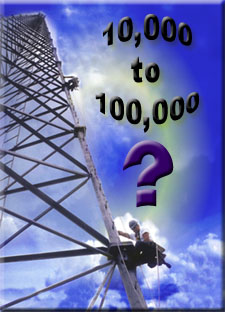
December 1, 2005 -- WirelessEstimator.com is undertaking a long overdue project to identify the approximate number of field personnel involved nationally in the "engineering, maintenance and construction of towers and other communications structures".
Due to the industry not having its own service codes, the National Institute of Safety and health is oftentimes quoted as stating that there are between 10,000 to 100,000 people in the industry that climb elevated structures. Unfortunately, not having a better estimate hurts the industry in many regards. In example, the Bureau of Labor Statistics is unable to accurately identify the number of fatalities in our industry per 100,000 employees. Please view: You can help!
To G or not to G: that is the question
Revision G standard set for January introduction, but acceptance may take up to three or more years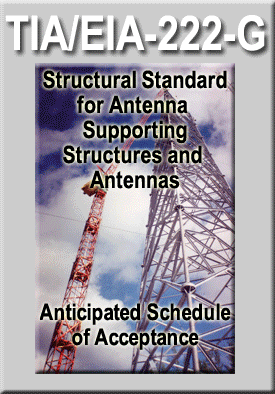
November 10, 2005 -- TIA/EIA-222-G will take effect January 1, 2006, but building departments may be years away from enforcing the long-awaited revision of the structural standard for antenna supporting structures and antennas.
The short answer for the lengthy delay: TIA/EIA-222-G is a voluntary standard and has no legal bearing. It only gains formidable strength if it's referenced by the International Building Code (IBC) or any other code, and the code is adopted by a permitting jurisdiction.
But the code referencing and adoption process is a long, sometimes arduous procedure that can oftentimes take years. For additional information, please see: Rev G Acceptance .
High angle rescue saves California man's life after illegal jump from 2,000-foot tower
November 2, 2005 - A Hayward, CA man was rescued last Thursday evening after he BASE jumped from a 2,000-foot tower and was left hanging for hours when 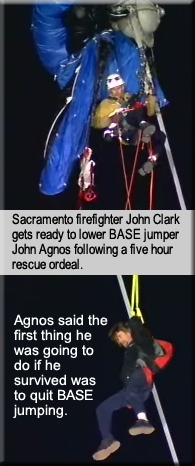 his parachute got tangled up in one of the structure's 2-1/2-inch guy wires at approximately 200 feet. his parachute got tangled up in one of the structure's 2-1/2-inch guy wires at approximately 200 feet.
Forty-one-year-old John Agnos entered the razor wire fenced compound, climbed the Walnut Grove, CA guyed tower and was enjoying a solo birthday evening jump that came close to ending all future celebrations. After jumping from the top of the structure and deploying his chute, Agnos was slammed against a guy wire and was severely jolted when he came to an abrupt stop when his chute and risers tangled around the tower's bridge strand.
After climbing the tower for almost three hours, Agnos said he jumped and his canopy opened correctly, but then struck a guy wire. He said his risers slid down the guy wire 400 or 500 feet, abruptly stopping almost 200 feet above ground. From available photographs taken at the scene, it initially appeared that he might have been saved when an insulator or some other accessory on the guy wire ensnared his chute's canopy.
"I jumped. I did a couple front flips off the tower and I started tracking away from the tower, so I thought I had plenty of separation and it was getting dark and I couldn't see the ground, so I thought I'd pull [the parachute rip cord] a little bit high," Agnos said. "That was my mistake."
For further information about the rescue efforts and a recording of his chilling 911 call, please visit: Frantic 911 call.
Over 40,000 daily storms find communications
equipment and structures to be easy strike targets
October 28, 2005 -- While the nation’s news has been riveted upon the damage and loss created by recent catastrophic hurricanes, billions of 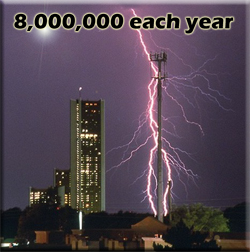 dollars in property loss reported from an estimated eight million lightning strokes each year remain a non event unless a fatality is involved. Severe lightning damage to communications sites is a daily event, but news of the destruction is most often found only in company balance sheets. Whereas new building codes and hurricane preparadness have helped to mitigate storm damage losses, according to lightning protection authority Curtis R. Stidham, lightning protection systems are available to lessen damage, but oftentimes specifiers concentrate too heavily on just low ground resistance. Please see: Grounding Protection. dollars in property loss reported from an estimated eight million lightning strokes each year remain a non event unless a fatality is involved. Severe lightning damage to communications sites is a daily event, but news of the destruction is most often found only in company balance sheets. Whereas new building codes and hurricane preparadness have helped to mitigate storm damage losses, according to lightning protection authority Curtis R. Stidham, lightning protection systems are available to lessen damage, but oftentimes specifiers concentrate too heavily on just low ground resistance. Please see: Grounding Protection.
FCC ruling releases backlog of 1,200 new tower builds held up in tribal review 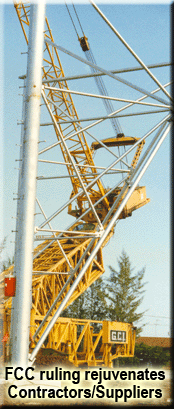 process process
October 7, 2005 -- There was collective industry applause yesterday evening following news that the Federal Communications Commission had issued a ruling that will allow approximately 1,200 new communications towers to be built throughout the nation.
The FCC's Declaratory Ruling brings a deadline to bear on a previously open-ended tribal consultation process that allows American Indian tribes to review proposed construction of towers that might be located on sites of historic or cultural significance. The ruling clarified situations in which tribes have not responded or objected to construction of cell towers.
The ruling is expected to promote a flurry of construction and manufacturing activity throughout the country as carriers quickly move forward to build their long-delayed sites.
In some areas the construction window for new sites is narrowing as winter sets in. South Dakota and North Dakota each have approximately 20 towers that will be able to be built based upon the ruling. A snowstorm struck much of North Dakota earlier this week. Please see: Prior procedure had no deadline.
Confused employers find little standardization in 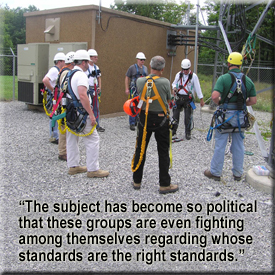 tower safety requirements tower safety requirements
By Winton W. Wilcox, Jr,
October 6, 2005 -- Employers of tower climbers trying to comply with regulations, standards and policies are doomed. First there is the legal need to comply with OSHA regulations. Second there is an increasing demand to meet the policies and standards as set by clients and property owners to avoid liability. Now NATE, NCDOL and ANSI as well as EIA/TIA have each published their own standards for employers to follow! All of these entities are self declared experts in tower safety. Each of these groups has produced "Tower Safety Standards," and by the way, MIOSH is reported to be progressing with their own version of these standards.
Each group was genuinely trying to provide clarification and guidance to employers who are charged with this responsibility; however, collectively they have successfully complicated the employer's task of complying. The subject has become so political that these groups are even fighting among themselves regarding whose standards are the right standards. Please see: Hanging by their teeth.
Snyder set to hand over National Association of Tower Erectors' reins to new leadership
October 5, 2005 -- After serving four years as Chairman of the National Association of Tower Erectors, Craig Snyder has elected not to run as a director for the 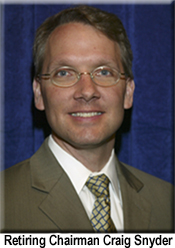 organization and will be leaving his leadership role on February 13, 2006 when NATE's newly seated board will select a new chairman. Craig's industry knowledge, organizational skills and boundless energy have helped the association move forward during a period that saw a precipitous drop in business as well as a resurgence today that has tower erection companies scrambling for employee resources. organization and will be leaving his leadership role on February 13, 2006 when NATE's newly seated board will select a new chairman. Craig's industry knowledge, organizational skills and boundless energy have helped the association move forward during a period that saw a precipitous drop in business as well as a resurgence today that has tower erection companies scrambling for employee resources.
Craig is the president and CEO of Sioux Falls Tower & Communications and is a founding member of NATE and has served on the board of directors since the association's inception in 1995.
He also serves as the Chairman of Telecommunications Industry Association committee that reviews and writes the TIA 222 Structural Standards for Steel Antenna Towers and Antenna Supporting Structures. He has held this position since 1998.
Gratifications and frustrations surfaced during his leadership and Craig spent time with WirelessEstimator.com last week to discuss them. Please see: Snyder Q&A .
As Crown becomes less international it may be eyeing SBA Communications as an acquisition
October 4, 2005 -- Crown Castle International Corp. is evaluating strategic alternatives for its investment in Crown Castle Australia, including a possible leveraged recapitalization or a sale of part or all of its interests. The US's second largest tower owner may also be courting SBA Communications as a possible consolidation target.
CCI has asked UBS Investment Bank to act as its advisor as it reviews its Crown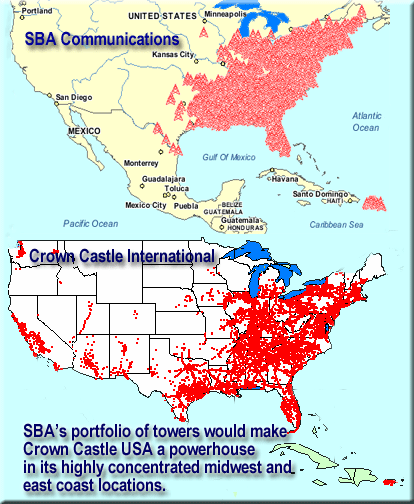 Castle Australia investment in Australia where it maintains a 78 percent ownership in the country's largest tower operator with 1,387 towers. Castle Australia investment in Australia where it maintains a 78 percent ownership in the country's largest tower operator with 1,387 towers.
Last year CCI sold its U.K. business which included 3,600 towers, to U.K. utility company National Grid Transco plc for $2.035 billion in cash.
There have been numerous industry rumors in past weeks that Crown Castle International is taking a serious look at purchasing Boca Raton, Florida-based SBA Communications, the oldest tower leasing/owner in the nation. Officials at both companies would not comment regarding the possibility of a sale. Adding SBA's 3,200 towers to Crown's portfolio would put the second largest tower owner at 14,000 towers.
At last month's PCIA Wireless Infrastructure Conference CCI President & CEO John P. Kelly said that he could not foresee CCI building a great amount of sites in 2006. He said that the company's focus would be upon maximizing revenue on existing towers and providing clients with available locations, even if it required identifying a competitor's structure as an alternative.
In other CCI news, Zachary Research analyst Patrick Comack said in a note to clients on Monday that Verizon Wireless plans to add to its media line-up by using Crown Castle's network to send live TV to its phones in the first quarter of 2006.
Comack said CCI plans to cover the top 30 U.S. markets with a live television network and that Verizon Wireless plans to deliver live TV using the network.
Mobile phone carrier service fares better following second Gulf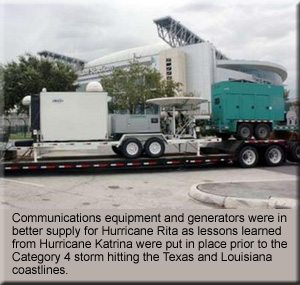 Coast hurricane catastrophe Coast hurricane catastrophe
September 26, 2005 -- The loss of commercial power appears to be the primary cause of disrupted cell phone service in areas hardest hit by Hurricane Rita from Galveston, TX to Lake Charles LA. With Rita's lower wind speeds and limited flooding, outages have been less destructive to wireless facilities. Most carriers will rely upon their Hurricane Katrina selected restoration contractors for assessment and repairs.
T-Mobile USA Inc. yesterday said more than 80 percent of cell sites in the Texas and Louisiana areas affected by Hurricane Rita now are operational. The company said disaster response personnel have been deployed to areas hardest hit by Hurricane Rita to conduct onsite recovery efforts. The team is deploying dozens of generators to the area to restore service to cell sites that lost commercial power.
Cingular Wireless L.L.C. said more than half of its cell sites in Texas and Louisiana areas pummelled by Hurricane Rita are working
Sprint Nextel said the bulk of its wireless outages from Rita occurred in Houston, where its network now is operating at 90 percent, and in Lake Charles.where crews are focusing on restoration efforts. Sprint Nextel also said 70 percent of its wireless network services are operational in the New Orleans market following Hurricane Katrina, and work is nearly complete in Mississippi, where the company has restored more than 95 percent of coverage.
Verizon Wireless said nearly 90 percent of the carrier's cell sites in areas devastated by Hurricane Rita are operational.
Former Nextel head targets solutions for disgraceful public safety communications 
September 19, 2005 -- The co-founder and former Vice Chairman of Nextel Communications says that the condition of public safety first responders' communications in the United States is a "total disgrace by any standard," and believes he might have a couple of ideas that can help solve the problem.
Widely regarded as a pioneer and visionary in the wireless industry, Morgan E. O'Brien informed key executives at the PCIA Wireless Infrastructure Conference on September 13 that he is obsessed with finding interoperability and redundancy solutions, but doubts that any breakthrough will come from established companies.
"I don't have the recipe for success. What I do have," O'Brien said, "are some of the ingredients for success." Two of O'Brien's solution elements are: 700 MHz and entrepreneurism. Please see: Experience may provide link to future.
Tower devastation from Katrina identified as carriers restore Gulf Coast communications 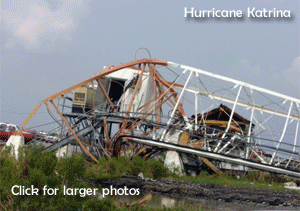
September 10, 2005 -- The tower still stands, but a Maypole skirt of coax drapes over a concrete monument that once supported an equipment shelter; a transceiver cabinet lies face up, incapable of spreading the news of its demise. A structure that once supported cell antennas lies on it side drinking toxic wastewater through its tubular legs as its shelter weaves drunkenly alongside on an elevated platform that begs for failure.
These are becoming frequent images as communications companies and service contractors are able to move into Gulf Coast communities to inventory severely damaged and decimated structures.
Although communications have improved in many areas after Hurricane Katrina dealt a massive blow to the infrastructure, full restoration is expected to take many months; New Orleans may not be completed for at least a year. Please see: Recovery on the way
NATE's rescue changes disregarded as North Carolina fall protection standard becomes law
September 8, 2005 - The good news, as the North Carolina Department of Labor sees it, is that the state's hotly contested Fall Protection Standard went 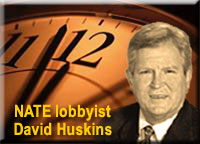 into effect last Friday; the good news, as the National Association of Tower Erectors sees it, is that two key safety requirements may be revised next May. If there's bad news it rests upon the shoulders of tower service companies who will be struggling with manpower resources to ensure that they can provide the rescue requirements the standard calls for regarding employee training. into effect last Friday; the good news, as the National Association of Tower Erectors sees it, is that two key safety requirements may be revised next May. If there's bad news it rests upon the shoulders of tower service companies who will be struggling with manpower resources to ensure that they can provide the rescue requirements the standard calls for regarding employee training.
The standard, which has become a Who's on First? legislative effort between a bureaucracy and business leaders, became law September 2 when the General Assembly adjourned without acting upon a Technical Corrections Bill before the House that contained an amendment that would have been beneficial to tower service companies. Please see: Standard in effect now.
As Hurricane Katrina strains resources, some tower firms declining 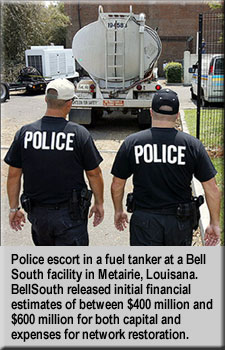 restoration service requests restoration service requests
September 6, 2005 - Tower service companies are carefully weighing whether they can provide the manpower to assist in the communications restoration efforts in the wake of Hurricane Katrina at a time when some company resources are already stretched as tight as a drum.
Two of the nation's largest tower service businesses requested that they did not want their companies mentioned, but told WirelessEstimator.com that although they have been asked to provide proposals for restoration teams, they have decided not to dedicate employees to the rebuilding effort.
"It's difficult as it is to maintain our current workload," explained one regional manager who has headed previous emergency communications projects, stating that they can't alienate carriers and management companies that are currently straining their resources to complete ongoing UMTS and other projects throughout the country.
Please view: Contractor restoration response.
Cellular carrier will try to abate $115,000 in fines stemming from Colorado tower climber's death
September 6, 2005 - Viaero Wireless of Fort Morgan, CO will be seeking reductions in their Occupational Safety and Health Administration (OSHA) citation fines 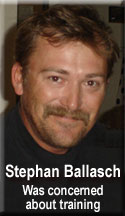 totaling $115,000 resulting from an accident west of Yuma on February 25 that caused the death of 35-year-old Stephan Ballasch when he fell 180' while working on a cellular tower. totaling $115,000 resulting from an accident west of Yuma on February 25 that caused the death of 35-year-old Stephan Ballasch when he fell 180' while working on a cellular tower.
According to Christine Corrigan, Team Leader of the Denver OSHA office, an informal conference will be held today to discuss the citations. Reductions in the amount of penalties can be made for good faith on the part of the employer and if there is no previous history of violations, Christine said.
In some cases, penalties may be reduced in exchange for a company's prompt correction of problems in order to protect their employees at the site and avoid litigation, explained OSHA area director Herb Gibson who emphasized that "This accident could have been avoided by following recognized safe work practices for climbing communication towers." Please see: One serious, two willful citations issued.
FCC relaxes rules to speed up broadcast recovery
September 2, 2005 -- In response to the devastation of Hurricane Katrina, the 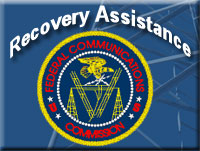 Federal Communications Commission’s Media Bureau will provide relief to multichannel video programming distributors (MVPDs), television and radio broadcasters by allowing systems and stations to operate and restore communications as needed in areas impacted by the hurricane. The FCC will allow FM and TV Stations to erect temporary antennas without prior authority and also allow AM stations to use full daytime facilities to broadcast during nighttime operations. Please see: FCC Notice. Federal Communications Commission’s Media Bureau will provide relief to multichannel video programming distributors (MVPDs), television and radio broadcasters by allowing systems and stations to operate and restore communications as needed in areas impacted by the hurricane. The FCC will allow FM and TV Stations to erect temporary antennas without prior authority and also allow AM stations to use full daytime facilities to broadcast during nighttime operations. Please see: FCC Notice.
American Tower and Crown Castle had greatest exposure in Hurricane Katrina’s impact area
September 1, 2005 -- In the highest impact areas of Hurricane Katrina, American Tower Corporation and Crown Castle International had the greatest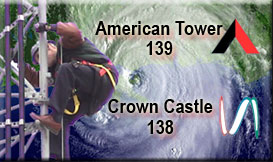 number of towers exposed to the crippling winds and flooding of the nation’s largest weather catastrophe. number of towers exposed to the crippling winds and flooding of the nation’s largest weather catastrophe.
American Tower has 139 towers, 90 of their portfolio coming from their merger with SpectraSite last month. Crown castle, according to Fryer’s TowerSource , has 138.
Figures were not immediately available for rooftop and other sites the companies own in the affected areas. Global Signal has 54 towers and SBA Communications, 42 structures. Other towers in the devastated areas totaled 778.
All four tower consolidators said that they have teams ready to inspect their structures and assist their clients when it is safe to enter the affected areas. For a complete breakdown of the 1,151 towers, their owners and locations, please visit, Hurricane Katrina Tower Count .
Carriers, contractors assessing communications restoration needs of pummeled Gulf Coast
August 31, 2005 -- Although initial reports reveal that numerous government, broadcast and cell towers collapsed in the Gulf Coast storm ravaged area from 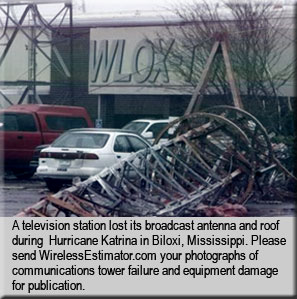 Hurricane Katrina, the catastrophic damage to infrastructure has shut down telecommunications in many areas of Louisiana, Alabama and Mississippi. Hurricane Katrina, the catastrophic damage to infrastructure has shut down telecommunications in many areas of Louisiana, Alabama and Mississippi.
Federal, state and community communications directors are trying to assess the damage but are having difficulty reaching their communications facilities. They are also in the process of planning and setting up temporary communications systems to help in their search and rescue missions. Cellular carriers are working with these agencies, but they too are unsure as to the extent of damage and the amount of time it will take to provide minimal service. Motorola has mobilized a 700MHz trunking system to New Orleans. Please see: Hurricane Katrina.
Fate of eleventh hour attempt by NATE to change NC safety standard may be decided on Monday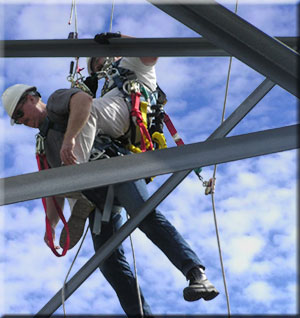
August 19, 2005 -- For more than five years the National Association of Tower Erectors and the North Carolina Department of Labor partnered to assemble the nation's first state communications tower standard, legislation that is being closely observed by other state occupational, safety and health organizations that might adopt it.
The fall protection section of the standard was to be effective April 1, along with the other eight sections, but NATE registered their concern with NCDOL about the language regarding high angle rescue requirements and both groups found there was strong disagreement following initial meetings and revisions. Please see: High Angle Rescue Training.
More competitive tower foundation bidding expected with new soil guidelines
August 14, 2005 -- Over the years, many towers have been installed throughout the country, with foundation designs that were based on "normal soil" parameters taken from the TIA/EIA 222 F standard and without the benefit of soil borings to identify actual conditions at the site.
Stamped drawings have been approved by building authorities without due regard for the actual soil properties at the site. Unfortunately, the error of this approach isn't obvious until such time as the catastrophic collapse of the tower exposes the faulty design.
When proper soil characteristics were not available at the time of bid preparation, the Structural Standard for Antenna Supporting Structures and Antennas made reference to a "normal soil" to facilitate foundation and anchor designs for bidding purposes. However, in the Revision G standard expected to be effective in January 2006, the technical committee took the position that the use of a term such as "normal soil" is not appropriate, and introduced the notion of presumptive soil parameters.
Please see: Default soil is now clay.
Second tower worker dies within two weeks
August 5, 2005 -- Butler County Missouri authorities have reported that an Alton, Illinois man had died Wednesday following a fall from a guyed tower in Poplar Bluff located in southeastern Missouri. Butler County Coroner Larry Cotrell said that 37-year-old Daniel Arnold fell from the structure and bounced off of a guy wire before landing in a field. Arnold was alive for a short time following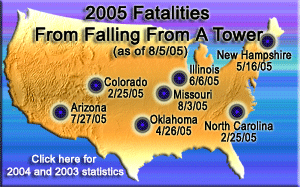 his fall and was treated at the scene by paramedics. He was later pronounced dead at Poplar Bluff Regional Medical Center. Workers believe that Arnold was in the process of attaching his safety lanyard when he fell. OSHA and police officials are conducting an investigation of the fatality. Arnold was employed by Tower Maintenance and Erection Corp. of Alton. his fall and was treated at the scene by paramedics. He was later pronounced dead at Poplar Bluff Regional Medical Center. Workers believe that Arnold was in the process of attaching his safety lanyard when he fell. OSHA and police officials are conducting an investigation of the fatality. Arnold was employed by Tower Maintenance and Erection Corp. of Alton.
On July 27 another tower technician was killed when he fell from a monopole in Apache Junction, Arizona. A spokesperson for the Apache Junction Police Department acknowledged that 46-year-old Frank J. Madrigal had died from a fall, but they said that details would only be released following completion of an autopsy and OSHA report. Frank Madrigal worked for CMI Communications of Phoenix.
NCDOL readies outreach training for new 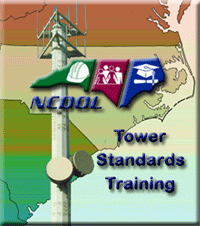 communication tower standards communication tower standards
August 4, 2005 -- The North Carolina Department of Labor, Occupational Safety and Health Division will be providing five outreach programs beginning August 15 to provide information about the recently introduced North Carolina Communication Tower standards to tower owners, lessees and employers performing work on communication structures. The educational seminars will discuss the state's Communications Tower, Fall Protection and Non-Ionizing Radiation standards. The fall protection standard is expected to take effect later this month. Please see: NCDOL.
Religious workplace discrimination seen as looming risk for telecommunications companies for telecommunications companies
August 1, 2005 -- Whenever possible, a mid-Atlantic tower crew prays together at lunchtime while members of a southeast carrier’s design group alerts others of the availability and significance of WWJD (What would Jesus do?) nylon bracelets. Most employees are not offended by these expressions of faith, but a fine line is being drawn between faith based initiatives and religious discrimination. Religious beliefs and practices at work are seldom considered at most companies as human resource managers focus upon employment fulfillment and institutional issues. Attorney and author Mark A. Lies, II believes religious discrimination is a looming risk. Please see: Religion in the workplace .
Procedural errors  shadow Supreme Court nominee's telecom views shadow Supreme Court nominee's telecom views
July 26, 2005 -- While interest groups at both ends of the political spectrum are focused upon identifying Supreme Court Justice nominee Judge John G. Roberts' positions on Roe v. Wade, the invalidation of affirmative action and other social and cultural issues, the PCIA and other industry organizations are trying to profile Judge Roberts' views on telecommunications issues. However, since he has written relatively few opinions in his two year tenure as a judge on the U.S. Court of Appeals for the D.C. Circuit, his views on a wide variety of telecom issues are still unknown. Unfortunately, two opinions he authored for the majority shed limited insight about the jurist's positions.
One case involved whether the Federal Communications Commission could require new televisions to include digital tuners. Judge Roberts wrote at length the possibility that the court was not authorized to hear the case because the plaintiffs had filed their challenge a day too early. A second case in his portfolio of 49 opinions involved a tower siting issue in Georgetown, SC. The court concluded that it lacked jurisdiction over the petitioner's claim that a BellSouth 185' monopole was constructed without an environmental assessment. Please see: SHPO snafu.

New protective grounding standard set for introduction
July 21, 2002 -- With the introduction of Revision G of the TIA/EIA 222 standard for antenna supporting structures and antennas, effective January 1, 2006, the standard for protective grounding will increase the minimum number of ground rods required and set a maximum number of ohms of total ground resistance. See: Grounding.
Crown Castle pays TrinTel $145 mil for 467 towers
July 12, 2005 - Crown Castle International Corp., a wireless tower operator, said it agreed to buy 467 towers from TrinTel Communications Inc. for $145 million, expanding its presence in U.S. metropolitan areas.
Houston-based Crown Castle said TrinTel's portfolio produces about $14.4 million in annualized site revenue, and $9 million in annualized site rental gross margin. The portfolio, built between 1998 and 2001, is generally concentrated in key U.S. markets such as Dallas-Fort Worth, Detroit and New Orleans, Crown Castle said. Privately held TrinTel is based in Irving, Texas.The acquisition is expected to close on or about August 1.
Document expected to be available in August
Revision G tower standard focuses heavily upon climber's safety for first time since 1949
June 27, 2005 -- If ANSI voting to be completed by July 5 is as positive as recent TIA support for the new Structural Standards for Steel Antenna Towers and Antenna Support Structures, the standard could become effective January 1, 2006, according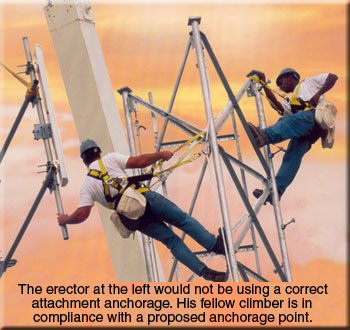 to Craig Snyder, Chairman of the TR-14.7 subcommittee which has labored for six years on Revision G of ANSI/TIA/EIA-222. The standard cleared TIA voting on June 13 with no negative votes. The document is expected to make it through the ANSI ballot process easily and should be available this August through www.tiaonline.org. to Craig Snyder, Chairman of the TR-14.7 subcommittee which has labored for six years on Revision G of ANSI/TIA/EIA-222. The standard cleared TIA voting on June 13 with no negative votes. The document is expected to make it through the ANSI ballot process easily and should be available this August through www.tiaonline.org.
With over 270 pages, the new standard eclipses Revision F's 115 pages with information and expanded content that covers technical issues such as wind and ice loading, seismic loading, design stresses and geotechnical requirements. Tower safety and climbing considerations are emphasized in detail and add to the TIA committee's belief that the standard will become internationally recognized. Please see: Revision G .
Arizona man is killed after 120' fall in Illinois
June 8, 2005 - A 43-year-old Arizona man was killed Monday after falling 120 feet from a partially dismantled tower in Lincoln, Illinois. A spokesperson for Logan County Coroner Robert Thomas' office identified the deceased to WirelessEstimator.com as Toby Wheale of Glendale. His name had been withheld earlier this week until police could notify his next of kin. Please see: Fall Fatality .
Nextel 800 MHz rebanding set to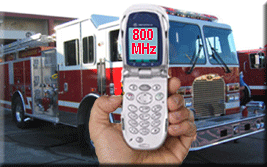 begin this month begin this month
June 1, 2005 – The Federal Communications Commission’s 800 MHz band reconfiguration will begin towards the end of the month, according to the FCC’s WirelessTelecommunications Bureau. Beginning June 27, a three-month voluntary negotiation period will begin for licensees to negotiate with Nextel Communications, followed by a three-month mandatory negotiation period.
Public safety departments have been anxious to see the rebanding process begin, which could take up to three years. The FCC's decision to reconfigure the 800 MHz spectrum, separating the incompatible technologies of public safety and commercial operations solves the pressing problem of radio interference at 800 MHz and provides additional spectrum for the future needs of first responders. Please see: Wave 1 States Listed.
Global Signal closes $1.2 billion Sprint tower transaction with purchase option transaction with purchase option
May 27, 2005 - Global Signal, Inc announced that it has closed its previousl y disclosed transaction with Sprint Corporation under which Global Signal will have the exclusive right to lease or operate approximately 6,600 communications towers for 32 years. Under the terms of the transaction, Global Signal will also have the option to purchase the towers and certain related assets from Sprint at the end of the lease term at a price of approximately $2.3 billion. At the closing, Global Signal paid approximately $1.2 billion in cash to Sprint for the transaction. Please see: Global Signal Closes Sprint Deal.
Web stitching investigated following Colorado tower climber's death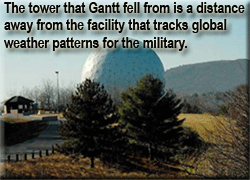 in New Hampshire in New Hampshire
May 18, 2005 - An accident at an Air Force satellite tracking base ended the life on Monday evening of a 55-year-old Colorado field engineer when he fell nearly 100 feet from a tower after removing equipment from the structure.
Frank Gantt was reportedly climbing down at the end of the day and took a break when he fell from the tower at the south-central New Hampshire New Boston Air Force Tracking Station.
The Peyton, Colorado resident had been an employee for the past 14 years of Honeywell Corporation, based out of their Colorado Springs office, according to Honeywell spokesman Bill Reavis, who said that Gantt had a strong work history of safety. Please see: Safety Equipment Failure Cited.
Zoning restrictions benefit many high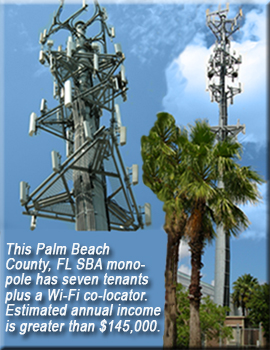 income tower site locations income tower site locations
May 16, 2005 -- Invigorating growth in wireless services data revenue, increased minutes of use and subscriber additions are creating daily deployment challenges for siting professionals tasked with obtaining new sites for the infrastructure required to meet customer quality and service demands.
Many local zoning authorities focus upon general aesthetics, instead of particular characteristics of the proposed facility, or engineering considerations of antenna system configurations. Some tony communities will only allow expensive concealment structures to provide for the least-intrusive site installation.
In an attempt to reduce the proliferation of towers, many jurisdictions now require that new towers must be designed to co-locate a minimum of three wireless carriers and call for the tower owner to certify that the tower will be reasonably available for co-location. Please see : Show us your Mona Lisa
New portfolio of towers: 22,000
American Tower to merge with SpectraSite in 3.1 billion deal creating nation's largest tower owner
May 4, 2005 -- During an earnings conference call this morning, American Tower Corp. announced that they have agreed to merge with SpectraSite Inc. in a $3.1 billion stock-for-stock transaction. The combination would create the largest tower company in North America with a site portfolio that exceeds 22,000 towers, eclipsing Houston-based Crown Castle with 10,600.
The merger agreement calls for SpectraSite shareholders to receive 3.575 shares of American Tower Class A common stock for each common share held. Both companies' boards of directors have already approved the deal. 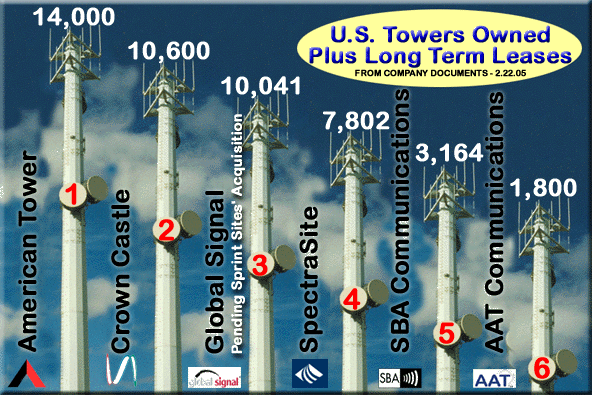
Further approval is needed from American Tower and SpectraSite shareholders. Based on American Tower's May 3 closing stock price, this exchange ratio equals $61.53 per share, a 9.5 percent premium over yesterday's closing price of SpectraSite. American Tower brings more than 14,000 sites to the merger. SpectraSite has approximately 7,800 sites. Some companies believe the merger could create problems for their businesses. Please see: Merger Concerns Surface .
As the state goes, so goes America?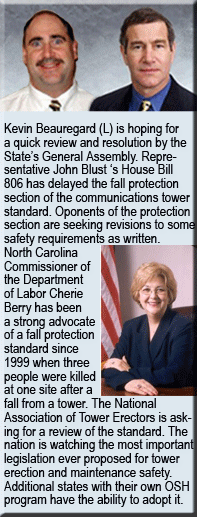
North Carolina to enforce new tower standard May 1st as the nation carefully watches
May 1, 2005 - North Carolina's Department of Labor will be enforcing the State's new communications tower standard on May 1st. Unfortunately, it will be missing two of its key safety sections that were authored to help prevent serious injury or death, according to Assistant Occupational Safety and Health Deputy Commissioner Kevin Beauregard who has spearheaded the new legislation at the direction of North Carolina Commissioner of Labor Cherie Berry. Fall Protection (13 NCAC 7F.0605) and Non-Ionizing Radiation (13 NCAC 7F.0606) will not be included in inspection activity and NCDOL outreach programs starting this week.
Beginning in 1999, Commissioner Berry became the nation's safety conscience as the most vocal proponent for a state and possibly federal consensus standard to protect a tower erector's and maintenance technician's safety. The nation's first death in 2005 from falling from a tower occurred in Wilson County, NC on February 25.
For a complete rundown of some of the industry concerns about the standard and its current status, please view: NC Fall Protection Standard Stalled .
Likelihood of an accident is found to be during the employee's first 30 days with company
April 11, 2005 -- Statistics indicate that more than half of all tower-related construction accidents occur to employees with less than one year with their company. According to a recent poll conducted onWirelessEstimator.com, 58% of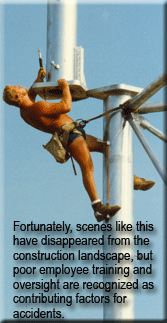 158 respondents last month said that their company's last accident involved an employee with tenure of one year or less. 158 respondents last month said that their company's last accident involved an employee with tenure of one year or less.
"That high percentage is not surprising and is certainly reflective of what we have been identifying," said Patrick Shea of Arthur J. Gallagher who tracks accidents and loss payments for the tower construction industry. "Our data in 2004 indicates that approximately 62% of our incurred losses were for employees with less than 12 months tenure," Shea said, identifying that the largest loss, 33% of all incurred payments, came from employees that had been employed less than three months. Shea manages the National Association of Tower Erector's insurance program that is underwritten by AIG.
Of more than 500 accidents reviewed, Shea said, 42% were in workers compensation category 5040 for those employees involved in steel erection. Tower maintenance as well as radio equipment installation were 9% each with steel fabrication at 8%. Painting was identified as providing 4% of the total. The lowest construction craft was telephone system installation at 2%. Fourty-one percent of all losses occurred between 8 a.m. and noon. Please see: Economics replaces training.
Supreme Court decision could set back tower siting as boards flex their authority
April 1, 2005 -- In a landmark 9-0 decision, the U.S. Supreme Court justices said the federal law that was designed to encourage the growth of the telecommunications industry does not allow cities to be sued for attorneys' fees and damages for refusing to permit a communications tower. The opinion could have wider implications in helping to determine the number and placement of cell phone towers around the country.
Local governments believe that the court's ruling will take some pressure off their zoning officials to approve permits for new cell phone towers. Some site acquisition and zoning specialists believe that it may encourage some communities to be more restrictive with onerous tower-siting requirements. Smaller tower consolidators will have to carefully assess whether they can afford to appeal subjective decisions and restrictions. pressure off their zoning officials to approve permits for new cell phone towers. Some site acquisition and zoning specialists believe that it may encourage some communities to be more restrictive with onerous tower-siting requirements. Smaller tower consolidators will have to carefully assess whether they can afford to appeal subjective decisions and restrictions.
Please see: Supreme Court decision could set back tower siting.
Tower titans see similar financial trends in 2005 
March 30, 2005 – American Tower Corp. and Crown Castle International, the nation’s largest tower owners with a combined portfolio of approximately 25,000 structures, announced their fourth quarter earnings today with Crown Castle narrowing its loss, while American Tower widened its loss. Both vertical real estate operators posted an increase in revenue. Please s ee: Q4 Results.
Since there is no Miranda warning
Employees are seldom aware of their rights during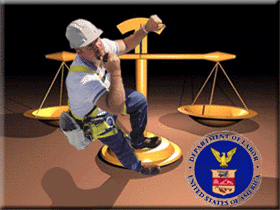 an OSHA interview an OSHA interview
As anyone who has ever experienced an OSHA inspection is well aware, a key element is the agency’s interviews of employees by the compliance officers from the U.S. Occupational Safety and Health Administration (OSHA). Unfortunately, a lot of confusion has occurred over the respective rights of OSHA, the employer and the employees. To learn about these respective rights during an interview.
See: Employee rights during an OSHA interview .
Silence of the Lamm tower death impels others to speak out about near misses to save other riggers
March 8, 2005 -- A 24-year-old North Carolina tower erector fell to his death on February 25, and 11 hours later a 35-year-old Colorado tower technician became another fatality when he fell 180'. No recorded tower-related deaths over the years have shown two on the same day in two separate states. Sadly, industry 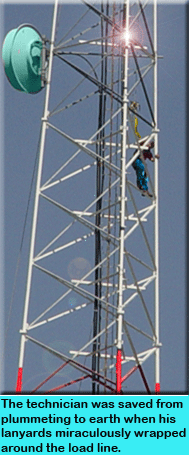 casualties follow a similar thread: The death becomes a short-lived media sensation; OSHA announces an investigation, results of which oftentimes end in obscurity, and the accident becomes buried in bureaucratic statistics as the deceased's family's loss and suffering lives forever. casualties follow a similar thread: The death becomes a short-lived media sensation; OSHA announces an investigation, results of which oftentimes end in obscurity, and the accident becomes buried in bureaucratic statistics as the deceased's family's loss and suffering lives forever.
John Paul Regan was the first fatality of 2005. He fell from a tower consolidator's 160' self supporting tower in North Carolina named "Silence of the Lamm" due to its proximity to Lamm Rd. in Wilson. However, it has been anything but quiet as his and Stephan Ballasch's deaths have provided a valuable industry legacy by inspiring riggers and company owners to publicly discuss accidents so that others will be alerted to their susceptibility of having a catastrophe of a similar nature.
Following the North Carolina accident, a company associate, not at the scene, said that Regan fell after wrapping his positioning lanyard to the antenna pipe and was leaning back. The pipe had only one attachment point and was lose. He said that Regan's weight caused the pipe to roll back. Apparently, a provided fall arrest lanyard was not in use, the employee said. The fellow erector stated that publishing this information might prevent another fellow steeplejack from making the same mistake.
An industry company owner agrees and has provided a harrowing account of an employee's near death experience. See: Industry speaks out following two company tragedies.
Second same day tower death shocks wireless construction industry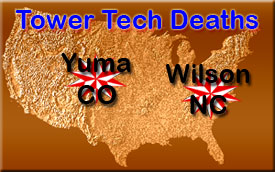
February 25, 2005 – Eleven hours following the first death of the year of a tower worker in North Carolina, another fatality has been reported in Colorado. According to the Denver office of OSHA, 35-year-old Stephan Ballasch was installing an antenna as an employee of Viaero Wireless near Yuma when the accident occurred at approximately 2:00 p.m. He fell from nearly 180’, a coworker said. Ballasch, who resided in Wray, is survived by a wife and three daughters.
He had been employed in the industry for less than two years, according to his father who wants the nation to know of the dangers of the profession. OSHA’s investigation of the accident could take from one to four months, according to area director Herb Gibson.
Viaero Wireless serves rural subscribers with GSM service in the Nebraska and Colorado markets and employs construction and employees for foundation and installation projects.
North Carolina erector’s death is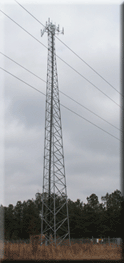 nation’s first 2005 tower site fatality nation’s first 2005 tower site fatality
February 25, 2005 -- According to the Wilson County, NC Sheriff’s Office, a 24-year-old Roxboro tower erector was killed in an accident that occurred at 3:15 a.m. John Paul Regan reportedly fell approximately 150 feet from a cell tower in Wilson County. Excel Tower Services President Bruce Yim said that Regan was performing a night antenna change out for Alltel on a structure owned by American Tower Corporation. With their corporate office in Wilson and a service office in Durham, Excel Tower Services has a combined leadership experience of over 25 years in the industry. Investigators said Regan reportedly was on the tower with a co-worker when he fastened a safety harness to an antenna on the tower that was not part of the structure of the tower. The antenna came loose and threw Regan away from the tower. An employee of Excel, not at the site, said that he had heard that Regan fell after wrapping his positioning lanyard to the antenna pipe and was leaning back. The pipe had only one attachment point and was lose. He said that Regan's weight caused the pipe to roll back. Apparently, a provided fall arrest lanyard was not in use, the associate said. The fellow erector stated that publishing this information might prevent another fellow steeplejack from making the same mistake.
Tower fatalities compiled by WirelessEstimator.com details this death as the first reported fatality in 2005 of a worker falling from a tower. The last reported death in NC was on 11/14/2003 in Asheboro when a 19-year-old Concord erector fell from a 250’ self supporting tower. The state Department of Labor says it's investigating the Wilson County accident, including what kind of fall protection equipment the worker was using. Nationally, six fatalities from falling from a tower structure were reported during 2004, a 50% reduction from the 12 deaths in 2003. The 160’ self supporting structure that Regan fell from, pictured above, is located between I-95 and Lamm Road, less than a mile from U.S. 264-A.
Global Signal acquires exclusive lease rights for Sprint Sites’ 6,700 towers at $178,000 each
February 21, 2005 -- Sprint Corp. has confirmed earlier reports that Global Signal Inc. will pay $1.2 billion to lease Sprint's wireless towers and other structures for 32 years, with an option to buy. structures for 32 years, with an option to buy.
Global Signal, based in Sarasota, Florida, will have exclusive rights to lease and operate more than 6,700 communications towers from Sprint, based in Overland Park, Kansas. Sprint will sublease space on the towers from Global Signal for 10 years, starting at $1,400 per month per tower. Global Signal will take over Sprint's existing collocation arrangements with tenants that lease space on the towers and will be able to sublease space on the towers to additional third-party tenants.
See: Sprint Sale for site locations and additional information.
Strong exhibition attendance highlights NATE's 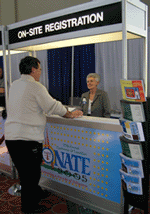 10th Conference and Exposition 10th Conference and Exposition
February 18, 2005 --The National Association of Tower Erectors celebrated its 10th anniversary during its annual conference and exhibition February 14-17, 2005 at the  Wyndham Anatole in Dallas, Texas. According to NATE Administrator Patrick Howey, pre-registration for the show had been excellent and the association was hoping to top last year’s 1,200 attendees. Patrick explained that on-site registration in Dallas was typically higher than most show locations due to the number of tower erection and associated companies within the tri-state area. Trade Show Chairman Ken Meador stated that exhibitors were appreciative of the excellent networking opportunities that the show provided. See: NATE show Wyndham Anatole in Dallas, Texas. According to NATE Administrator Patrick Howey, pre-registration for the show had been excellent and the association was hoping to top last year’s 1,200 attendees. Patrick explained that on-site registration in Dallas was typically higher than most show locations due to the number of tower erection and associated companies within the tri-state area. Trade Show Chairman Ken Meador stated that exhibitors were appreciative of the excellent networking opportunities that the show provided. See: NATE show for a recap of the 10th anniversary event and show photographs. for a recap of the 10th anniversary event and show photographs.
Bowers bags C-note for multi-site
monitoring message
February 3, 2005 --One hundred dollars is on its way to Blake Bowers of West Plains, MO after he was selected for adding a forum message to WirelessEstimator.com’s Discussion Forum. Each month a member is randomly chosen after submitting a forum message, Lesson Learned or adding a comment to an existing one. His message discussing multi site monitoring appears under the Remote Site Monitoring category in the Discussion Forum.
Blake has been in the industry for the past 16 years and is currently the real estate operations manager for a regional tower company with towers from Maine to Colorado.The company has a portfolio of 60-plus towers and more than 30 BTS sites. The next drawing will be February 28, 2005.
Broadcaster fined $10,000 for endangering tower technician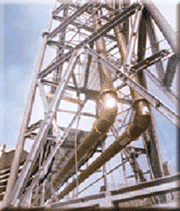 repairing transmission line leak repairing transmission line leak
January 16, 2005 -- The FCC has fined the nation's second largest broadcasting company $10,000 for allowing a tower worker to be exposed to dangerous levels of radiation that resulted in smoke coming from the bottom of the worker's RF protection suit.
Based upon evidence brought before the FCC, Cumulus Broadcasting was cited for allowing the worker to be exposed to power levels in excess of the occupational levels that exceed RFR exposure limits. According to the FCC's calculations, the tower technician could have been exposed to levels exceeding 9,200% of the occupational RFR MPE limit. See: Lock-out Tag-out Violation
FAA replacing replacement parts policy; comments being requested
December 16, 2004 -- Although there has been a detailed procedure in place for 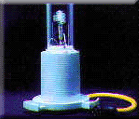 aviation obstruction lighting manufacturers to certify their products, the certification program did not provide a method for certifying replacement components and the FAA published a Notice of Policy on June 17, 2004 in the Federal Register stating that the use of components by non-original equipment manufacturers could degrade aviation safety and was not acceptable. Less than five months later they changed their mind. aviation obstruction lighting manufacturers to certify their products, the certification program did not provide a method for certifying replacement components and the FAA published a Notice of Policy on June 17, 2004 in the Federal Register stating that the use of components by non-original equipment manufacturers could degrade aviation safety and was not acceptable. Less than five months later they changed their mind.
See: Non-OEM parts certification
Andrew acquires many of American Tower's 24 construction offices, 340 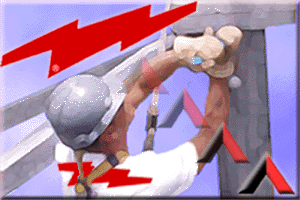 employees employees
December 14, 2004 -- American Tower Corporation has completed the sale of its tower construction unit, ATC Tower Services, Inc., to Andrew Corporation, a global communications systems and equipment supplier. Andrew had entered into a definitive agreement in October to acquire selected assets of the construction group for approximately $10 million, consisting of cash and the assumption of certain capital lease obligations.
See: American Tower construction group sold
Sprint sale expected to have an impact upon many national vendors and contractors national vendors and contractors
December 12, 2004 --The planned sale of Sprint's portfolio of 6,700 communications sites to one of the major tower companies could affect contracts that are currently in place with Sprint’s vendors. Companies that are presently providing engineering, lighting repairs, maintenance, installations and retrofitting will be required to be approved by the successful bidder's management unless they have already been pre-qualified. They might also have to compete against existing contractors to renew opportunities.
See: Sprint Sale
Contractors and vendors optimistic about
new 800 MHz band and other opportunities 
December 9, 2004 -- Some industry analysts believe it could cost Nextel three billion dollars to meet the FCC's 800 MHz reconfiguration order to ensure that 800 MHz public safety licensees and other 800 MHz incumbents receive comparible facilities to complete the FCC-mandated channel changes. Nextel says it will cost $815 million, but the FCC is asking for a $2.5 billion dollar letter to credit to ensure that they have adequate funding. The reconfiguration will provide a much needed boost to vendors and contractors, but the national impact is still being weighed, especially now due to the Sprint and Nextel merger plans.
See: New Band Expected to Play Out Profits for Contractors and Vendors
More Briefs:
FCC Announces New Band Configuration for 800 MHz
|